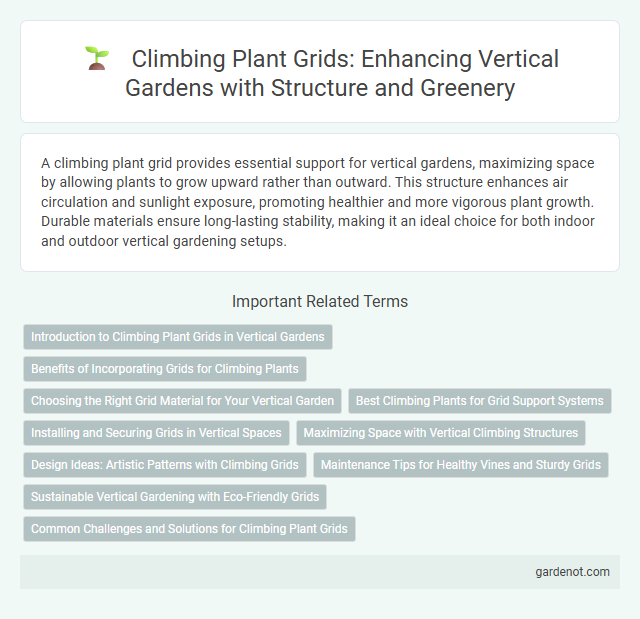A climbing plant grid provides essential support for vertical gardens, maximizing space by allowing plants to grow upward rather than outward. This structure enhances air circulation and sunlight exposure, promoting healthier and more vigorous plant growth. Durable materials ensure long-lasting stability, making it an ideal choice for both indoor and outdoor vertical gardening setups.
Introduction to Climbing Plant Grids in Vertical Gardens
Climbing plant grids serve as essential structural supports in vertical gardens, enabling vines and creepers to grow upward efficiently. These grids are typically made from durable materials such as metal or plastic, designed to withstand outdoor elements while providing ample space for plant attachment. Incorporating climbing plant grids enhances plant density and vertical coverage, maximizing green space in urban or limited areas.
Benefits of Incorporating Grids for Climbing Plants
Incorporating climbing plant grids enhances vertical gardens by providing essential support for plant growth and maximizing space efficiency. These grids promote healthier development and better air circulation, reducing the risk of disease and encouraging vigorous flowering or foliage display. Utilizing grids also simplifies maintenance and creates visually striking green walls that improve urban biodiversity and air quality.
Choosing the Right Grid Material for Your Vertical Garden
Selecting the ideal climbing plant grid material for your vertical garden involves balancing durability, weight, and plant compatibility. Metal grids, such as galvanized steel or aluminum, offer robust support and weather resistance, making them perfect for heavy climbers like ivy or wisteria. In contrast, plastic or bamboo grids provide lightweight, flexible options suited for lighter plants like morning glories or small vines.
Best Climbing Plants for Grid Support Systems
Climbing plant grids provide excellent vertical support for a variety of species such as English ivy, clematis, and climbing roses, which thrive by attaching themselves securely to the grid structure. These plants benefit from grids made of durable materials like galvanized steel or UV-resistant plastic, ensuring stability and longevity for healthy growth. Selecting fast-growing, hardy climbers like jasmine or honeysuckle enhances coverage and visual appeal while promoting air circulation and reducing wall dampness.
Installing and Securing Grids in Vertical Spaces
Installing climbing plant grids in vertical gardens ensures robust support for vines and creepers, promoting healthy growth and aesthetic appeal. Secure grids using corrosion-resistant anchors and appropriate fasteners to withstand outdoor conditions and plant weight. Proper tensioning and alignment optimize plant adherence and facilitate maintenance in vertical spaces.
Maximizing Space with Vertical Climbing Structures
Climbing plant grids maximize space by allowing vines and creepers to grow vertically, transforming small areas into lush green walls. These vertical climbing structures support plants like ivy, jasmine, and clematis, increasing greenery without occupying ground space. Utilizing durable materials such as metal or wood ensures stability and longevity, making the most of limited urban gardens or balconies.
Design Ideas: Artistic Patterns with Climbing Grids
Climbing plant grids transform vertical gardens by creating intricate artistic patterns that enhance visual appeal and plant growth. These grids guide vines like ivy, jasmine, and clematis into geometric shapes, adding texture and depth to walls or fences. Utilizing materials such as metal or wood grids tailored to specific plant types ensures both aesthetic beauty and structural support for thriving climbers.
Maintenance Tips for Healthy Vines and Sturdy Grids
Regularly inspect the climbing plant grid for any signs of rust or damage to ensure long-lasting support for healthy vines. Prune the vines frequently to prevent overcrowding and promote air circulation, reducing the risk of fungal diseases. Secure loose stems to the grid using soft ties to encourage vertical growth and maintain structural stability.
Sustainable Vertical Gardening with Eco-Friendly Grids
Climbing plant grids made from recycled materials enhance sustainable vertical gardening by providing eco-friendly support for vines and creepers. These grids promote efficient use of space and natural air purification while reducing plastic waste in garden designs. Incorporating biodegradable or metal grids ensures long-lasting durability with minimal environmental impact.
Common Challenges and Solutions for Climbing Plant Grids
Climbing plant grids often face challenges such as inadequate support leading to plant damage, limited space restricting growth, and difficulty in maintenance due to dense foliage. Solutions include using durable, rust-resistant materials like galvanized steel for the grid, ensuring proper spacing between plants to promote airflow and healthy growth, and implementing a structured pruning schedule to prevent overcrowding. Selecting fast-growing, hardy climbing plants compatible with the grid structure improves overall vertical garden durability and aesthetics.
Climbing plant grid Infographic

 gardenot.com
gardenot.com